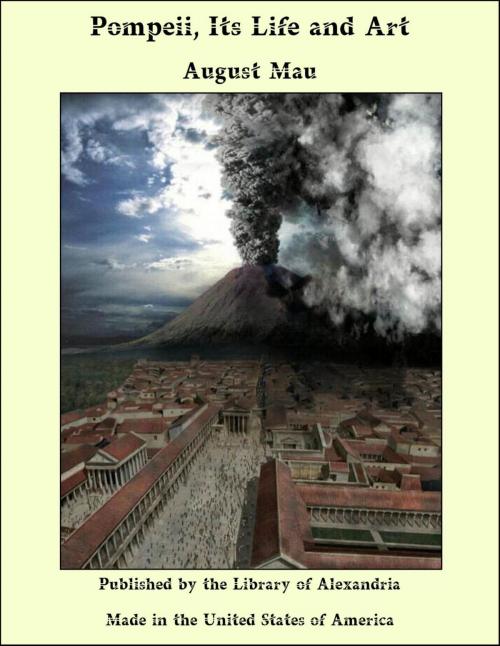Pompeii, Its Life and Art
Nonfiction, Religion & Spirituality, New Age, History, Fiction & Literature| Author: | August Mau | ISBN: | 9781465581686 |
| Publisher: | Library of Alexandria | Publication: | March 8, 2015 |
| Imprint: | Language: | English |
| Author: | August Mau |
| ISBN: | 9781465581686 |
| Publisher: | Library of Alexandria |
| Publication: | March 8, 2015 |
| Imprint: | |
| Language: | English |
From Gaeta, where the south end of the Volscian range borders abruptly upon the sea, to the peninsula of Sorrento, a broad gulf stretched in remote ages, cutting its way far into the land. Its waves dashed upon the base of the mountains which now, rising with steep slope, mark the eastern boundary of the Campanian Plain—Mt. Tifata above Capua, Mt. Taburno back of Nola, and lying across the southeast corner, the huge mass of Monte Sant' Angelo, whose sharply defined line of elevation is continued in the heights of Sorrento. This gulf was transformed by volcanic agencies into a fertile plain. Here two fissures in the earth's crust cross each other, each marked by a series of extinct or active volcanoes. One fissure runs in the direction of the Italian Peninsula; along it lie Monti Berici near Vicenza, Mt. Amiata below Chiusi, the lakes of Bolsena and Bracciano filling extinct craters, the Alban Mountains, and finally Stromboli and Aetna. The other runs from east to west; its direction is indicated by Mt. Vulture near Venosa, Mt. Epomeo on the island of Ischia, and the Ponza Islands. At three places in the old sea basin the subterranean fires burst forth. Near the north shore rose the great volcano of Rocca Monfina, which added itself to the Volscian Mountains, and heaping the products of its eruptions upon Mons Massicus,—once an island,—formed with this the northern boundary of the plain. Toward the middle the numerous small vents of the Phlegraean Fields threw up the low heights, to which the north shore of the Bay of Naples—Posilipo, Baiae, Misenum—is indebted for its incomparable beauty of landscape. Finally, near the south shore, at the intersection of the fissures, the massive cone of Vesuvius rose, in complete isolation—the only volcano on the continent of Europe still remaining active. Its base on the southwest is washed by the sea, while on the other sides a stretch of level country separates it from the mountains that hem in the plain. On the side opposite from the sea, however, Vesuvius comes so near to the mountains that we may well say that it divides the Campanian plain into two parts, of which the larger, on the northwest side, is drained by the Volturno; the small southeast section is the plain of the Sarno.
From Gaeta, where the south end of the Volscian range borders abruptly upon the sea, to the peninsula of Sorrento, a broad gulf stretched in remote ages, cutting its way far into the land. Its waves dashed upon the base of the mountains which now, rising with steep slope, mark the eastern boundary of the Campanian Plain—Mt. Tifata above Capua, Mt. Taburno back of Nola, and lying across the southeast corner, the huge mass of Monte Sant' Angelo, whose sharply defined line of elevation is continued in the heights of Sorrento. This gulf was transformed by volcanic agencies into a fertile plain. Here two fissures in the earth's crust cross each other, each marked by a series of extinct or active volcanoes. One fissure runs in the direction of the Italian Peninsula; along it lie Monti Berici near Vicenza, Mt. Amiata below Chiusi, the lakes of Bolsena and Bracciano filling extinct craters, the Alban Mountains, and finally Stromboli and Aetna. The other runs from east to west; its direction is indicated by Mt. Vulture near Venosa, Mt. Epomeo on the island of Ischia, and the Ponza Islands. At three places in the old sea basin the subterranean fires burst forth. Near the north shore rose the great volcano of Rocca Monfina, which added itself to the Volscian Mountains, and heaping the products of its eruptions upon Mons Massicus,—once an island,—formed with this the northern boundary of the plain. Toward the middle the numerous small vents of the Phlegraean Fields threw up the low heights, to which the north shore of the Bay of Naples—Posilipo, Baiae, Misenum—is indebted for its incomparable beauty of landscape. Finally, near the south shore, at the intersection of the fissures, the massive cone of Vesuvius rose, in complete isolation—the only volcano on the continent of Europe still remaining active. Its base on the southwest is washed by the sea, while on the other sides a stretch of level country separates it from the mountains that hem in the plain. On the side opposite from the sea, however, Vesuvius comes so near to the mountains that we may well say that it divides the Campanian plain into two parts, of which the larger, on the northwest side, is drained by the Volturno; the small southeast section is the plain of the Sarno.















